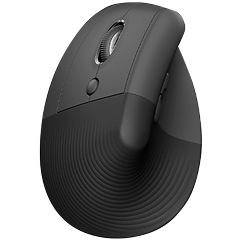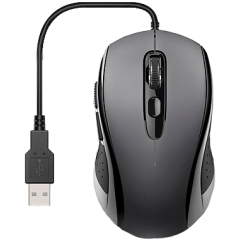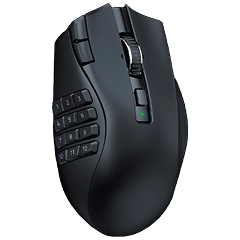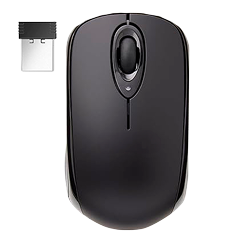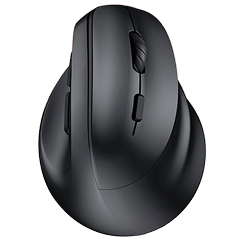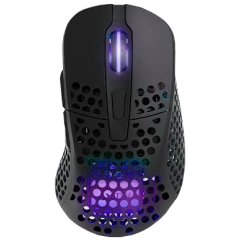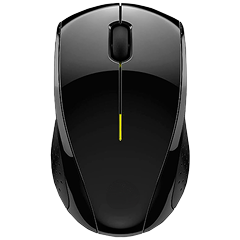If it’s time to move on from that basic mouse that came with your PC a few years ago, or if you’re building your first gaming PC and want a mouse to match, it can be overwhelming knowing where to start when shopping online. There’s no shortage of different options, from size and shape to raw specs and bonus features. There’s a lot to take into consideration and even more brands to choose between too.
To help make that decision a little easier, I’ve pulled together a guide that covers not only what to look for on a spec sheet but also a few talking points you might not have considered.
Mouse Types
The first question to ask yourself when shopping for a new computer mouse is what you’re looking to do with it and what you need it for a majority of the time. Obviously you can use a gaming mouse for office work, and you’ll still be able to game with an ergonomic mouse, but deciding your primary use case before starting to look around will help focus your search.
There are always outliers, of course, but primarily computer mice fall into three broad categories; Gaming, Productivity and Ergonomomic. Each has their own headline features, pros and cons, so let’s break down what makes each of them unique.
Gaming Mice
This is generally the cutting edge category. It’s gaming mice that seem to gather the most attention when it comes to development and certainly where you’ll find the most fanfare. Much like how Formula 1 cars are the innovators for tech and engineering that trickles down to the road cars you and I drive daily, gaming mice are the breeding ground for mouse-based innovation.
Gaming mice prioritize performance, with raw data and technical specifications mattering far more here than elsewhere. You’ll be able to really noticeably feel the difference in how each mouse behaves on screen, governed by its sensor specs, and having the wrong mouse for the job could be the difference between winning and losing your next match.
Gaming mice are further divided into multiple subcategories, with different options in the market for specific game types. Exactly how these are labelled will change from one brand to the next but expect to see terms like MMORPG Mouse, MOBA Mouse and FPS Mouse. This can be a handy place to start if you’re locked into a particular genre of game, if you’re a World of Warcraft player then you’ll likely be best off starting your search in the MMO category, while the benefits of these mice will be far lower for a Counter-Strike 2 player.
Not all gaming mice are quite so nichely defined however, and there are a huge number of neutral, all-round options to choose from too. Don’t feel compelled to buy an aggressively MOBA-tilted mouse just because Dota 2 is your main game. It’s a good place to start your search but make sure to poke around other categories too. What else do you play? Or perhaps more importantly, what else do you use your PC for? If you’re also a creator who spends time editing videos, you may want to consider a more balanced, less extreme gaming mouse with fewer edge-case features but a boost to ergonomic comfort.
Productivity Mice
Designed for all day work use, productivity mice have come a long way from the basic blobs you’ll find littering offices across the world. Taking cues from gaming mice but paring things back, productivity mice prioritize comfort over long periods with an emphasis on quality of life features. These kinds of mice tend to be more subtle, you won’t find RGB lighting effects here, instead look for muted designs in simpler form factors.
Don’t be alarmed if product listings for productivity mice don’t push specifications and benchmarks to the forefront, some may not even mention them at all. Just because a brand doesn’t call out the polling rate of an office mouse doesn’t mean it’s bad, they’re probably not trying to hide anything. It’s just not that relevant and most users don’t really care. While sensor performance is crucial for gaming, for the mundane movements of an office mouse the difference between one sensor and another may not be noticeable at all.
Instead of worrying about raw specs with productivity mice, look to headline features and physical characteristics. Does your mouse spend half its life in a laptop bag moving between your home and office desks? Consider a wireless mouse with a slim form factor. Do you perform a lot of repetitive tasks or rely on keyboard shortcuts? Consider an option with mouse gestures and additional mappable buttons.
Ergonomic mice
Easily the most ‘out there’ mouse type, ergonomic mice can get seriously funky. Shape is the most important factor here as they focus on keeping your hand in the most natural position possible. Much more so than gaming or productivity mice, ergonomic mice are a matter of personal preference as they can take quite a bit of getting used to.
Vertical mice are the most common option — they tend to stick closely to a traditional mouse shape but tilt it around 60 degrees to keep your wrist in less of a stress position. There’s conflicting studies on the short- and long-term impacts here. This isn’t a miracle cure for anything, but some people may simply find it more comfortable and it’s certainly not going to make things worse.
Trackball mice shift the workload away from your wrist and forearm and instead have your fingers do the work. They’re a great choice for people with reduced mobility, but can also offer a far greater level of fine control too. For CAD designers and engineers, beyond ergonomic considerations, a trackball may just be a better choice full stop.
Key Features Explained
We’ve talked about when and why you’d want to focus on the raw specifications of a mouse, but it’s important to know what you’re actually looking for too. There’s plenty of numbers to be thrown around and knowing which are the ones that matter most to you is key. Let’s break down some of the most common terms you’ll see when shopping for a mouse and how they impact using it in the real world.
DPI
This is your main sensitivity metric. The higher the Dots Per Inch, the more sensitive your mouse will be to movement and the faster the cursor will be able to move on screen.
At a technical level, the DPI number you’ll see on product pages reflects how many dots (in this case, pixels on your screen) the cursor will move for every one inch of physical movement of the mouse. All mice have a DPI metric, though you’re more likely to see it being advertised for gaming mice than office options.
Bigger isn’t always better with DPI though and you shouldn’t assume that a mouse with a higher max DPI is a better choice than one with a lower DPI. At a certain point, high DPI values become more of a vanity metric than a realistically usable one.
For example, some modern gaming mice are promoting DPIs as high as 30,000, which is technically impressive and may be a representation of a high quality sensor, but won’t deliver a sensitivity anyone is likely to actually use.
The good news however, is DPI is rarely a fixed metric and the number you’ll see quoted on product pages is generally a maximum rather than a static number. Almost all modern gaming and productivity mice from known brands will offer adjustable DPI, some via a handleful of presets with others offering more granular control via software.
This delivers great flexibility and some users may choose to change their DPI on the fly between different apps, games, or even different situations within a game like when switching between weapon types.
Polling Rate
Polling rate is how often your mouse reports its position to your PC and as a result, how precise the data is that your machine has to work with. This is measured in Hz, and much like the refresh rate of a gaming monitor it’s a case of higher numbers equalling a smoother result.
There’s no point having a really having DPI setting with a low polling rate, for example, because your PC won’t know exactly where your mouse has moved to often enough to accurately reflect this on screen. This can result in your mouse feeling choppy or stuttering, disconnected from your movements. A high polling rate however will feel smooth and responsive, much more in tune with how you’ve actually moved the mouse.
A higher polling rate is generally better. However, there is a limit to this as processing all of that input data can put a strain on your PC and there are diminishing returns at the upper end anyway.
For gaming, look for a polling rate around 700-1000Hz. Going much higher than this won’t deliver benefits and may actually cause reduced in-game performance. For productivity, lower polling rates are fine and unlikely to impact on your experience, though try not to go too far below 250Hz if possible.
Tracking Speed
Tracking speed is more of a consideration for gaming mice where accurately keeping up with fast movements is important. These specs are exactly that — the maximum speed the mouse sensor is able to track movement. This is generally measured in Inches Per Second (IPS) and we’re looking for plenty of headroom here, better to be safe than sorry.
Most people are unlikely to be able to move a mouse much faster than about 100 IPS, but that isn’t to say 100 IPS is all you need when it comes to maximum tracking speed. Mouse movements are short, sharp bursts and you need to make sure there’s capacity in your mouse sensor to keep up.
- For gaming, look for tracking speeds of around 400 for a high-end mouse, though somewhere between 200 and 300 IPS is probably fine for most people.
- For productivity this number is again less important, but avoid going too far below 100 IPS if possible.
Acceleration
Related to tracking speed is the acceleration spec of a mouse and once again this is all about ensuring a consistent flow of accurate data to your PC. While tracking relates to the maximum speed a mouse sensor can still collect data without errors, the acceleration rating is purely related to the change in speed it can handle along the way.
This is measured in G-force and how important it is will depend entirely on your use case.
- For productivity, you can almost ignore the acceleration metric all together.
- For gaming you’ll want to aim for something above 30G for general gaming and as high as 70G for high-end or professional gaming.
LOD
While again less of a problem for productivity and work users, lift-off distance is an often overlooked metric that can actually be quite impactful for gamers. This measures the height above your desk or mouse mat where the mouse sensor stops tracking, and therefore stops reporting its position to your PC.
Ideally, you only want your mouse cursor to move when your mouse is in contact with your surface and under control, not while you’re repositioning it, so a lower LOD is always better.
Look for the smallest number possible, ideally around 1mm, though depending on your use case this may not be an impactful metric.
Macro Buttons
Apart from the cheapest options on the market, almost all mice — gaming, productivity, or ergonomic — will likely feature at least one or two extra buttons. These will generally come pre-bound with common actions like navigating between browser pages or adjusting DPI on the fly, however most will also include software to map these to any input.
As it’s software controlled, it’s also often possible to map macro commands or a series of inputs to a single button press. For productivity this can be a real time-saver, particularly for tasks with repetitive inputs. For gaming, specific MMO mice exist which are covered in an incredible array of programmable buttons. Some of the higher-end MMORPG mice will feature as many as 20 additional buttons for assigning to different in-game keybinds.
Grip Style
While it will rarely be specified on a product page, it’s important to be aware of your preferred grip style and make sure the physical shape of the mouse you’re looking at will support this. Mice tend to be divided into two grip styles, claw and palm.
Claw grippers will hold the mouse primarily using their fingertips with their fingers curled. This generally allows for greater precision control and faster clicks.
If you prefer a claw grip, look for mice with a smaller main body and a lighter overall weight.
Palm grippers nestle the main mouse body deep into their hand with maximum contract between mouse and hand. This is generally a more ergonomic option that provides more stable control, great for productivity and slower-paced games.
If you prefer a palm grip, look for a more pronounced main body and additional thumb rest support.
With so many options available, choosing a new mouse can actually be quite a tricky task. We’ve created a scoring system to pit one against the next in objective metrics, but the right mouse for one person may be completely wrong for another, regardless of what reviews and scores say. To help get you on the right track, see if any of these examples sound like you.
Casual PC User
You use your PC for a mix of work, gaming, and general productivity.
Look out for:
- A mouse that supports your preferred grip type
- A well-known, reliable brand
- A balanced mix of technical specs and features
Productivity Power User
You primarily need a mouse for work, often with repetitive admin and office tasks.
Look out for:
- A mouse with ergonomic physical characteristics, generally palm grip
- Programmable macro buttons
- Adjustable DPI at the lower end of the spectrum
- Free scrolling wheels
Hot Desker
You use your mouse primarily for work, but across devices and different locations.
Look out for:
- Smaller form factor
- Multi-device, wireless connectivity
- Software support with profiles
Content Creator
You spend a lot of time in creative and editing apps, possibly gaming on the same machine too.
Look out for:
- Programmable buttons
- Adjustable DPI
- Reasonable polling rate
Casual Gamer
You mainly use your PC for gaming but play a variety of game styles.
Look out for:
- Mid-range DPI, IPS and polling rate states
- Mappable buttons
- The right form factor for your grip style
FPS Gamer
You find yourself focusing primarily on FPS games with a need for fast, but controlled movements.
Look out for:
- Easily adjustable DPI with a good range
- Strong acceleration and polling rate numbers
- A lighter, claw grip option
MMO Gamer
Most of your gaming is in MMORPG or MOBO games.
Look out for:
- A high number of programmable buttons
- Very high DPI, polling rate and IPS stats
- A mouse with a little more weight
Pro Gamer
You play games at a particularly high standard and want to push the technical limits.
Look out for:
- Very high DPI, polling rate and IPS stats
- Adjustable specs across game types
- Wired over wireless
- A smaller, lighter form factor
Much like console controllers, people are often quick to try and shun the idea of a wired option mouse. Why bother with a wire when wireless mice are just as good, right? Well, it’s not always quite that simple. There are situations where wired mice can be superior to their wireless counterparts and it’s all a matter of what you’re using it for and how your PC is set up.
Wired
Pros
- No input lag — Wires are able to near-instantly transmit data, in high-end gaming this can be the difference between winning and losing.
- Flawless connectivity — Cables aren’t at risk of signal interference that can cause irritating dropouts and hiccups.
- No battery management — No charging needed!
- Lighter weight — Because wired mice have no internal battery, they’re often noticeably lighter and can even feature completely hollow designs.
Cons
- Cable drag — Having a wired mouse means dealing with a wire. Cables can snag or create resistance, affecting control. This can be resolved with a bungie if needed.
- Less portable — Most mice include at least a 1m cable, which can be irritating to travel with.
- Needs cable management — Some people hyper-focus on cable management and a wireless option resolves that clutter immediately.
Wireless
Pros
- Freedom of movement — Without a physical tether to your machine you’re granted a full range of movement with no drag or resistance.
- Added portability — A wireless mouse is easier to use between multiple PCs or workspaces.
- Can free up a USB port — Gaming mice in particular will often require a USB dongle, however Bluetooth mice can connect directly.
- Less desk clutter — The lack of cable makes it easier to maintain a sleek, tidier desk.
Cons
- Battery management — While the battery life of a lot of modern mice is measured in days, not hours, you’ll still need to keep an eye on that battery percentage and keep things charged.
- Potential interference — Wireless connections are prone to interference from other devices.
- Usually heavier — Batteries are surprisingly heavy and in devices weighing so little, that added weight can be noticeable.
Setup and Ergonomics
Whether it’s for work or gaming, you’re likely to use your mouse for long periods so overlooking form factor and ergonomics can have serious consequences. Be realistic about your choices, prioritizing comfort and support over flashy looks. Before anything else, consider your preferred and natural mouse grip and base your search around this. Forcing yourself to use a small mouse as a palm gripper is not going to end well.
The performance of your mouse comes down to more than just the mouse itself. The surface you use it on can have a drastic impact on its feel and how your movements translate on screen. For general productivity work you may be able to get away with using your desk surface. For gaming, however, it’s highly recommended to invest in a high quality mouse mat.
There’s a wide range of options available including both hard and soft pads. Pay close attention to product listings and seek out user reviews to make sure the characteristics of the mat match what you’re looking for.
As a general rule, hard mouse mats will offer far less resistance, resulting in a much higher movement speed and a feeling of greater sensitivity as a result. However this comes at the expense of control and stopping power, particularly with lighter mice running at higher DPIs. Some brands also now offer wireless power mouse mats that combine with specific mice to offer a permanently powered, battery-free wireless mouse.
Brands
Logitech is one of the most recognized and trusted mouse brands worldwide. This brand makes everything from entry-level office mice to high-end gaming models under the Logitech G and MX series. Build quality is consistently strong, even on lower-cost models. Higher-end models are known for their premium materials and long lifespan.
The customer support is generally responsive and easy to reach. Most products come with a 1–2 year warranty, with solid RMA processes.
Focused on gaming, Razer offers a wide lineup of mice ranging from ultra-light FPS models to ergonomic MMO-focused designs. The performance is strong, though some users report issues with long-term switch reliability (especially in older models). The build quality on premium models is high. The support can be hit or miss depending on the region. Warranty is usually 2 years, but response times may vary.
Known for well-built, performance-driven mice aimed at competitive gamers. SteelSeries mice are commonly used in esports. They use solid materials and have good build quality. Newer models like the use durable switches and water-resistant coatings. The customer support is generally reliable, with a 1–2 year warranty and straightforward support process.
Corsair offers a variety of mice with a focus on gaming, especially for FPS and MMO players. Many models have distinctive RGB lighting and software customization. Build quality is generally good, though some lower-tier models can feel bulky. Higher-end mice are more refined and durable. Corsair offers a 2-year warranty and decent global support, especially for RMA claims.
Glorious is a newer brand focused on high-performance gaming mice with minimalist, ultra-light designs, popular among FPS gamers. The durability and quality is strong for the price with lightweight but well-engineered shells. They have a reputation for fast, responsive support. Warranties are typically 1 year, though coverage is fair.
There are some other brands worth mentioning too, like:
- Zowie (by BenQ): Highly respected in competitive gaming for plug-and-play simplicity and consistency. No software required. Premium pricing, no RGB, and a focus on shape and performance.
- Microsoft: Known for ergonomic office mice like the Sculpt Ergonomic and the Classic IntelliMouse. Great for long work sessions, but less focus on gaming.
- Apple: The Magic Mouse offers sleek design and gesture support, but has limited ergonomics and is not recommended for long-term productivity or gaming.
For budget buyers, Logitech consistently offers reliable, no-frills mice that outperform many competitors in terms of durability and user experience. Their software is also easy to use, and warranties are dependable.
In the mid-range segment, both Logitech and Razer offer excellent value. They’re great for productivity and gaming respectively, while Razer’s series combine solid build quality with responsive performance for their price. SteelSeries is also a strong contender in this range, especially for gamers who want lightweight designs and good sensor performance without paying top dollar.
At the premium level, Logitech, Razer, and Glorious lead the pack depending on your needs. Logitech’s MX Master series is widely considered the best for productivity, with ergonomic design, great battery life, and software flexibility. For gaming, Razer’s more high-end models offer top-tier sensors, ultra-light builds, and excellent responsiveness, making them favorites among competitive players. SteelSeries also holds its own at this tier, especially with its Prime and Aerox lines.
Summary/Recap
There may be a huge range of different types of mice, shapes, styles, and brands to choose from, but hopefully I’ve now helped organize your thoughts when it comes to choosing the right option. Take your time to suss out what options are available, start by identifying your needs and preferences before compiling a shortlist of frontrunning options. Then let price and availability enter the picture. Peripherals often pop up in sales and on short-term deals so it may pay to track prices unless you’re in a rush.
Consider what works for other people too. Popular mice are popular for a reason and there’s no shame in following the crowd when their needs closely align with yours. Read reviews, both from tech review sites but also on online marketplaces and ecommerce listings, and search for model names on forums and platforms like Reddit to get an idea of how people are talking about the mouse you’re considering. Chances are there’ll be people just like you who have hands-on experience with the good and bad sides of every mouse on your short list.
And finally, remember that while there are large differences between mice at the very ends of the spectrum, the difference between two mice that are closely related is often minor. Provided you’ve put some level of research into your decision you’re not likely to go too far wrong. Take your time to make an educated choice and you’ll be happily working and gaming in no time.


